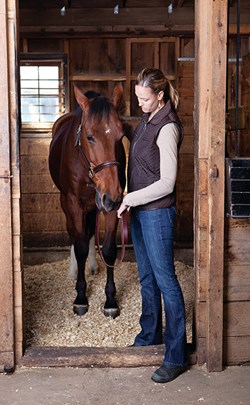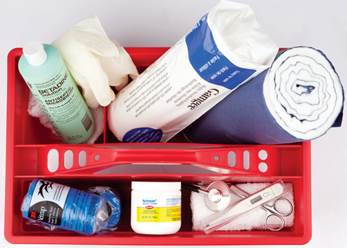Equine 911: When to Call the Vet
By: Dr. Lydia Gray
Updated on: 2/19/2020Which of these is an emergency and requires a veterinarian be contacted immediately?
- Horse squinting and tearing from one eye
- Horse unwilling to move when asked to walk
- Horse paws, rolls, gets up, bites at side, rolls again
- All of the above
Here is a list of common horse emergencies which require a veterinarian be contacted immediately:
- Squinting, tearing, cloudiness, or injury to the eye
- Unable to bear weight on a limb or stand, unwilling to move
- Laminitis
- Colic
- Neurologic signs (physical or behavioral)
- Profuse bleeding
- Full-thickness skin laceration, a puncture, or a wound near joint
- "Choke"
- Difficulty breathing
- Extremely high fevers (above 103 degrees)
- Difficulty foaling

How do I know my horse is sick?
One of the first signs that a horse might be sick or injured is when he stands apart from the rest of the herd. Other signs that should alert you to a problem that may require veterinary attention include other changes in behavior; nasal discharge, cough or fever; changes in eating, drinking, urinating and defecating; bumps or swellings; or lameness.To make sure you can find it when you need it, your veterinarian’s regular and emergency phone numbers should be posted by the barn phone and in your first aid kit, as well as programmed into your cell phone. Be prepared to describe the situation to your veterinarian, including when you first noticed the problem, what you have done (if anything) to treat it, any relevant facts from your horse’s past, as well as its attitude, stance, temperature, pulse and respiration (Normal: T = 99 – 101, P = 28 – 42 bpm, R = 8 – 16 bpm). Not sure how to take your horse’s temp, pulse and respiration? Learn how to take your horse’s vital signs here. Your veterinarian will determine if your horse needs to be seen and how soon.
So I called my vet, now what?
Situation one: It’s an emergency and the veterinarian is coming right out.While you have your veterinarian on the phone, ask if there are any medications you should or should not give your horse, if it is better to keep the horse still or moving, if you should offer or withhold food or water, and if there is anything you should have ready when he or she arrives. A bucket of warm water and towels often come in handy, as do blankets for your horse (in cold weather). For critical injuries or diseases, consider having extra people on hand and getting a trailer ready to ship the horse to a clinic.
Situation two: It’s not an emergency but the veterinarian still needs to come out.
Find out exactly how you should manage your horse until the veterinarian has a chance to examine him, diagnose the problem, and recommend a treatment plan. Should he be kept in a stall or turned out with the herd? Should he stay on his regular diet or receive a different ration? Should you start medication now or wait until the veterinarian sees him? Besides vital signs, what else should you be closely monitoring for changes? Problems that may fall into this category include lameness and hives.
Situation three: You and your veterinarian agree the problem is not serious right now and you have the skills to manage it.
Problems that may fall into this category include wounds that are not full-thickness and low-grade fever. With close monitoring and regular nursing care, you may be able to resolve problems like these without direct, on-site professional help. However, if the situation worsens or the horse does not improve as quickly as anticipated, you should contact your veterinarian for additional advice or an examination.

What to have in your horse's First Aid Kit
If you own or are responsible for a horse, then you must be prepared for accidents, injuries, and illnesses. Use the lists below to start a conversation with your veterinarian about what items should be in your barn first aid kit (and in a separate trailer first aid kit if you travel with your horse). Ultimately, what items you have on hand should be only those that you have been trained on and know how to use.
A Sample First Aid Kit:
- Phone numbers: vet, trailer, friends, clinic
- Thermometer
- Scissors (bandage and other)
- Antibiotic ointment
- Saline
- Iodine or chlorhexidine scrub
- Iodine or chlorhexidine solution
- Cling wrap (Vet wrap or other)
- Needles (18g x 1.5)
- Hoof pick
- Gloves
- Flashlight
- Sterile gauze squares (regular and nonadherent)
- Gauze rolls
- Cotton roll or other padded wrap (eg gamgee, Army Navy)
- Ace, polo or track bandages
- White bandage tape
- Duct tape
- Syringes (60cc with two tips)
- Pen or marker
- Towels
- Tweezer or pliers
- Stethoscope
Also good to have around the barn:
- Clippers
- Additional syringes and needles (3cc, 12cc, 35cc; 20g X 1.5)
- Epsom salts
- Poultice
- Liniment
- Aspirin
- Nitrofurazone ointment
- Ichthammol ointment
- Brown paper
- Kitchen cling wrap
- Electrolytes
- Instant heat or cold packs
- Fly repellent
- Horse blanket
- Pill crusher
- Phenylbutazone
- Flunixin meglumine
- Antibiotic (sulfa tabs or penicillin)
- Tranquilizer
Learn to recognize injuries and illness in your horse and contact your veterinarian as soon as you notice a problem. By working together to do what is best for your horse, you may increase your horse’s chance for a full recovery and decrease the drain on your wallet.
SmartPak strongly encourages you to consult your veterinarian regarding specific questions about your horse's health. This information is not intended to diagnose or treat any disease, and is purely educational.
Article First Published December 2007